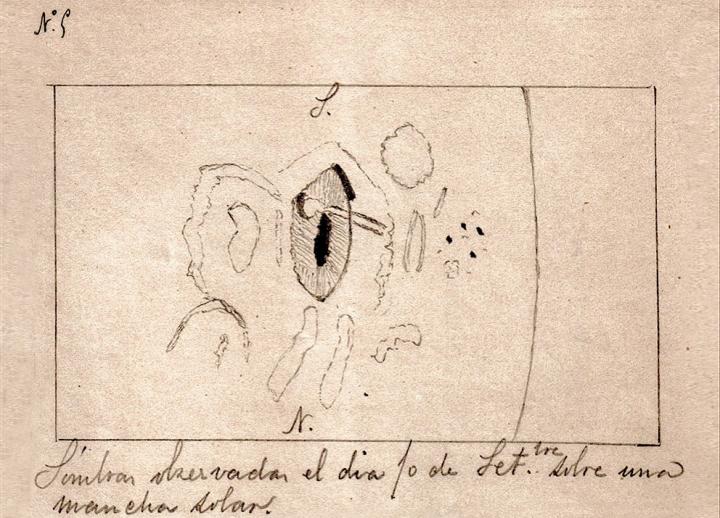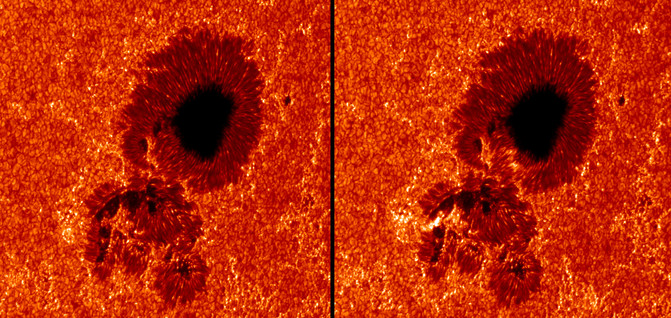How a 19th-Century Teenage Astronomer Documented a Rare Solar Flare

Recently, Spanish astronomers found the writings of a little-known teenager who made an incredible contribution to the study of the sun.
More than a century ago, 17-year-old Juan Valderrama y Aguilar turned to his notebook to draw a powerful white-light flare that was blasting off the sun's surface and casting a shadow near a sunspot, all visible to him through a small telescope. This marks the third-earliest recording of a white-light solar flare in history, according to a statement from the Spanish Foundation for Science and Technology.
White-light solar flares occur when the sun's magnetic-field lines twist and reconnect with so much energy that they produce visible light and bursts of plasma that, should they reach Earth's atmosphere, may cause geomagnetic storms and disrupt telecommunications. Scientists observed at least nine powerful solar flares in early September of this year, and the X-class flare that was released on Sept. 6, 2017, was the most powerful blast seen in the past 12 years. [In Photos: The Sun's Monster X9.3 Solar Flare of Sept. 6, 2017]
"White-light flares correspond to the most extreme cases of [solar flares], where so much energy is dumped into the chromosphere and corona that the energy propagates downward to the photosphere, heating it up and producing the excess brightness that we observe in white light," Jorge Sánchez Almeida, of the Canary Islands Astrophysics Institute, said in the statement.
Sánchez Almeida and his fellow researchers at the Canary Islands Astrophysics Institute and the University of Extremadura, both located in Spain, recently located Valderrama's drawing, which is the third recorded instance of a white-light flare..
Valderrama's amateur observations were just the beginning of his career in astronomy, and according to the statement, the young man would go on to become the director of the meteorological observatory of Santa Cruz de Tenerife in the Canary Islands, where he was born.
To make his observation, Valderrama used a neutral density filter to dim the sunlight shooting into his telescope, and with a modest aperture of 6.6 centimeters (2.6 inches), he watched the spectacle unfold over the course of a day. "A huge, beautiful sunspot was formed," Valderrama wrote, according to the statement. "[B]y looking at it carefully, I noticed an extraordinary phenomenon on [it]: a very bright object ... producing a shadow clearly visible on the sunspot penumbra."
Breaking space news, the latest updates on rocket launches, skywatching events and more!
Valderrama sent his data to the French journal L'Astronomie, where it was published soon after.. The findings are incredible because white-light flares are rare, the researchers said, and because he observed the unique solar event despite being young and operating with limited technology.
"[T]he white-light flare observed by Valderrama is, chronologically, the third one recorded in the history of solar physics," José Manuel Vaquero, a lecturer at the University of Extremadura, said in the statement. The first solar flare was recorded in 1859 by British astronomer Richard Carrington, and Italian astronomer Pietro Angelo Secchi described the second flare in 1872.
Follow Doris Elin Salazar on Twitter@salazar_elin. Follow us @Spacedotcom, Facebook and Google+. Original article on Space.com.

Doris is a science journalist and Space.com contributor. She received a B.A. in Sociology and Communications at Fordham University in New York City. Her first work was published in collaboration with London Mining Network, where her love of science writing was born. Her passion for astronomy started as a kid when she helped her sister build a model solar system in the Bronx. She got her first shot at astronomy writing as a Space.com editorial intern and continues to write about all things cosmic for the website. Doris has also written about microscopic plant life for Scientific American’s website and about whale calls for their print magazine. She has also written about ancient humans for Inverse, with stories ranging from how to recreate Pompeii’s cuisine to how to map the Polynesian expansion through genomics. She currently shares her home with two rabbits. Follow her on twitter at @salazar_elin.

